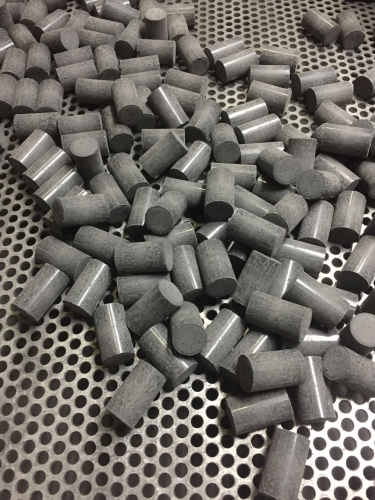Hysol GR640HV-L1 | Black Epoxy Mold Compound
- Improved electrical performance version of GR640HV
- Ideal for TO, SMX and SOT/SOD Packages
- JEDEC 1 260°C capable product
Product Description
Hysol GR640HV-L1 is a black, heat-curable epoxy molding compound that delivers outstanding performance and ease of use. This material is designed to achieve JEDEC Level 1 requirements at 260°C reflow temperature. It is an improved version of GR640HV with better electrical performance version.
Hysol GR 640HV-L1 is a "Green" low stress product with low cost of ownership that meets the strict MSL1 JEDEC requirements. It is designed for semiconductor discrete packages such as TO220, TO247 and other TO packages, SMA, SMB and other SMX packages and Transformers. It is developed for eutectic bonding and not for die attach bonding. In eutectic bonding, an intermediate metal layer that forms a eutectic composition with either or both of the bonded components is used. Eutectic bonding is a low-temperature process, which is beneficial for temperature-sensitive applications where high temperatures affect the integrity of the device components. It is important to check the compatibility of Hysol GR640HV-L1 with the bonding process to maximize its excellent moisture sensitivity capability. GR640HV-L1 meets UL 94 V-0 Flammability at ¼ inch thickness.
Technical Specifications
| General Properties | |||||||
| Color Color The color | Black | ||||||
| Filler Content | 78 % | ||||||
| Specific Gravity Specific Gravity Specific gravity (SG) is the ratio of the density of a substance to the density of a reference substance; equivalently, it is the ratio of the mass of a substance to the mass of a reference substance for the same given volume. For liquids, the reference substance is almost always water (1), while for gases, it is air (1.18) at room temperature. Specific gravity is unitless. | 1.88 | ||||||
| |||||||
| Thermal Properties | |||||||
| Glass Transition Temperature (Tg) Glass Transition Temperature (Tg) The glass transition temperature for organic adhesives is a temperature region where the polymers change from glassy and brittle to soft and rubbery. Increasing the temperature further continues the softening process as the viscosity drops too. Temperatures between the glass transition temperature and below the decomposition point of the adhesive are the best region for bonding. The glass-transition temperature Tg of a material characterizes the range of temperatures over which this glass transition occurs. | 178 °C | ||||||
| UL 94 Rating UL 94 Rating Flammability rating classification. It determines how fast a material burns or extinguishes once it is ignited. HB: slow burning on a horizontal specimen; burning rate less than 76 mm/min for thickness less than 3 mm or burning stops before 100 mm V-2: burning stops within 30 seconds on a vertical specimen; drips of flaming particles are allowed. V-1: burning stops within 30 seconds on a vertical specimen; drips of particles allowed as long as they are not inflamed. V-0: burning stops within 10 seconds on a vertical specimen; drips of particles allowed as long as they are not inflamed. 5VB: burning stops within 60 seconds on a vertical specimen; no drips allowed; plaque specimens may develop a hole. 5VA: burning stops within 60 seconds on a vertical specimen; no drips allowed; plaque specimens may not develop a hole | V0 | ||||||
| |||||||
| |||||||
| Electrical Properties | |||||||
| Volume Resistivity Volume Resistivity Volume resistivity, also called volume resistance, bulk resistance or bulk resistivity is a thickness dependent measurement of the resistivity of a material perpendicular to the plane of the surface. | 1.2x1016 Ohms⋅cm | ||||||
| Mechanical Properties | |||||||
| |||||||
| |||||||
| |||||||
| Chemical Properties | |||||||
| Moisture absorption | 0.4 % | ||||||
| |||||||
| Physical Properties | |||||||
| Spiral Flow @ 175°C | 140 cm | ||||||





